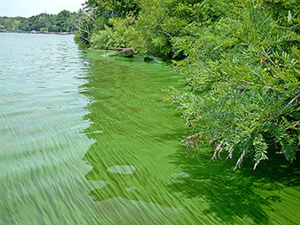319. Reducing water pollution from agricultural fertilizers
I gave a talk to the Ontario Ministry of Agriculture, Food and Rural Affairs (OMAFRA) on July 16, 2019, exploring ways to reduce water pollution from agricultural fertilizers.
Many methods have been proposed to reduce water pollution from agricultural fertilizers. The list includes use of nitrification inhibitors, land retirement, vegetation buffer strips along waterways, flood-plain restoration, constructed wetlands, bioreactors, cover crops, zero till and getting farmers to reduce their fertilizer application rates.
 Last year, while I was at the University of Minnesota for several months, I reviewed the literature on these options and came to the conclusion that the option with the best prospects for success is reducing fertilizer application rates. It’s the only one of these options that is likely to be both effective and cheap.
Last year, while I was at the University of Minnesota for several months, I reviewed the literature on these options and came to the conclusion that the option with the best prospects for success is reducing fertilizer application rates. It’s the only one of these options that is likely to be both effective and cheap.
In my talk, I made the case for agencies who are trying to reduce pollution to focus on reducing fertilizer rates.
In brief, I identified three key reasons why there are untapped opportunities to reduce fertilizer rates.
1. Some farmers apply more fertilizer than is in their own best interests. Surveys in the US suggest that something like 20 to 30% of American farmers could make more profit if they reduced their rates. If it was possible to identify these farmers and convince them of this, it would be a rare win-win for farmers and the environment.
2. Even those farmers who currently apply fertilizer close to the rates that would maximize their profits could cut their rates without sacrificing much profit. Within the region of the economically optimal rate, the relationship between fertilizer rate and profit is remarkably flat. New estimates by Yaun Chai (University of Minnesota) of this relationship for corn after corn in Iowa indicate that farmers could cut their rates by 30% below the profit-maximizing rate and only lose 5% of their profits from that crop. For corn after soybeans, the equivalent opportunity is for a 45% cut!
 3. Some farmers believe that applying an extra-high rate of fertilizer provides them with a level of insurance. They think it reduces their risk of getting a low yield. However, the empirical evidence indicates exactly the opposite. When you weigh up the chances of an above-average yield and a below-average yield, higher fertilizer rates are actually more risky than lower rates. In addition, price risk interacts with yield risk to further increase the riskiness of high rates.
3. Some farmers believe that applying an extra-high rate of fertilizer provides them with a level of insurance. They think it reduces their risk of getting a low yield. However, the empirical evidence indicates exactly the opposite. When you weigh up the chances of an above-average yield and a below-average yield, higher fertilizer rates are actually more risky than lower rates. In addition, price risk interacts with yield risk to further increase the riskiness of high rates.
I think there is a real opportunity to explore these three factors in more depth and try to come up with policy approaches that could deliver reduced fertilizer usage in a highly cost-effective way. Some of it would just be about effective communication (e.g. the design of “nudges”, as popularised in behavioural economics) while some might require a modest financial commitment from government or industry. One idea is to offer something like a money-back guarantee to those farmers who agree to reduce their rates by a specified amount. If they lose money as a result, they get compensation. Because of the flatness of the fertilizer-profit relationship, the payments required would usually be very small.
I recorded the presentation to OMAFRA, and it’s available here.
Further reading
Pannell, D.J. (2006). Flat-earth economics: The far-reaching consequences of flat payoff functions in economic decision making, Review of Agricultural Economics 28(4), 553-566. Journal web page * Prepublication version here (44K). * IDEAS page
Pannell, D.J. (2017). Economic perspectives on nitrogen in farming systems: managing trade-offs between production, risk and the environment, Soil Research 55, 473-478. Journal web page
This is interesting! In one of my projects on science and economics of soil ‘health’, we’re trying to work out the amount of legacy nutrients in a ‘healthy’ soil that could inform by how much to reduce fertilizer use, even below agronomic requirements. Assuming farmers look after the ‘health’ of their soil, though at a cost, but they realise the benefit of reduced fertilizer required by taping into legacy nutrients. Hoping the benefit will match or exceed the cost.
Yes, high levels of legacy nutrients in the soil mean that the payoff function to fertilizer moves to the left – the economically optimal rate is at a lower fertilizer rate. Farmers not realising this (and continuing to apply high rates) would be an example of reason 1 in my list of three reasons why there are untapped opportunities to reduce fertilizer rates.
Is this strictly American data or does it include Australia Dr Pannell?
Thanks for the question Brandy-Lee.
The particular study I cite about the percentage of farmers who apply more fertilizer than a reference rate is for the US. I have not seen equivalent data for Australia, but my judgment is that the percentage of Australian farmers is probably broadly similar.
The story about the flatness of the payoff function (the relationship between fertilizer rate and profit) is general, and international. Lots of data on this from many countries.
In the talk (see the video at the bottom of the post) I post four sets of data that show that higher fertilizer rates increase the level of risk a farmer faces. Two of those are for Australia and two are for the US. The amount of empirical evidence out there on this point is much less than for the flatness issue, but there is enough of it, and it is consistent enough, that I am confident this is generally applicable too.
Really interesting presentation. Is the literature review of the water quality practices you mentioned available anywhere?
Hi Gwen. Thanks. Not yet. We are still considering how to publish it. I will put up a blog post when it is available.
Thank you for the presentation and posting it online. Have you or your colleagues done similar work looking at flat payoff functions with phosphorus fertilizer, including environmental risk?
There has been a lot more research on nitrogen, but I’m sure the situation with phosphorus is very similar. I have not gone looking for data for P, but I have seen it in the past. All you need is field research where yield is measured for a wide range of P fertilizer rates. Then convert yield to revenue and fertilizer rate to variable cost and take the difference, and that’s the payoff function.
I have some good recent field data on agronomic responses to P in wheat and canola. Some will be published in the Australian Agronomy Conference later this month. Kerry Stott submitted a paper on economic optimisation component to the Australian Journal of Agricultural and Resource Economics. We have an Excel-based decision support model online with these payoff functions.
https://communities.grdc.com.au/crop-nutrition/try-new-decision-support-tools-better-hrz/
I attended the American Agronomy Conference in 2017 and was told by a research agronomist that it is rare to find a response to P in US cropping soils. Nevertheless there is a starter P effect, that crops supplied with MAP in the drill row grow better initially even in soils of a high soil test. Nevertheless I was surprised that in the US south, soybean and cotton crops are sown without starter P, because it meant seeding was quicker.
PM me for more information.
Hi Malcolm. Many thanks for this. Jennifer can follow up with you for more on P.
Yes, lack of a response at all is an even better reason to cut the use of P. Over-application of P over a number of years can mean that the optimal rate now is zero. P tends to hang around much longer than N.
Thank You for sharing nice info. It is our duty to make it easy for you to conserve daily use of water.
Visit: http://watflux.in/water-meters/domestic-household-water-meters/